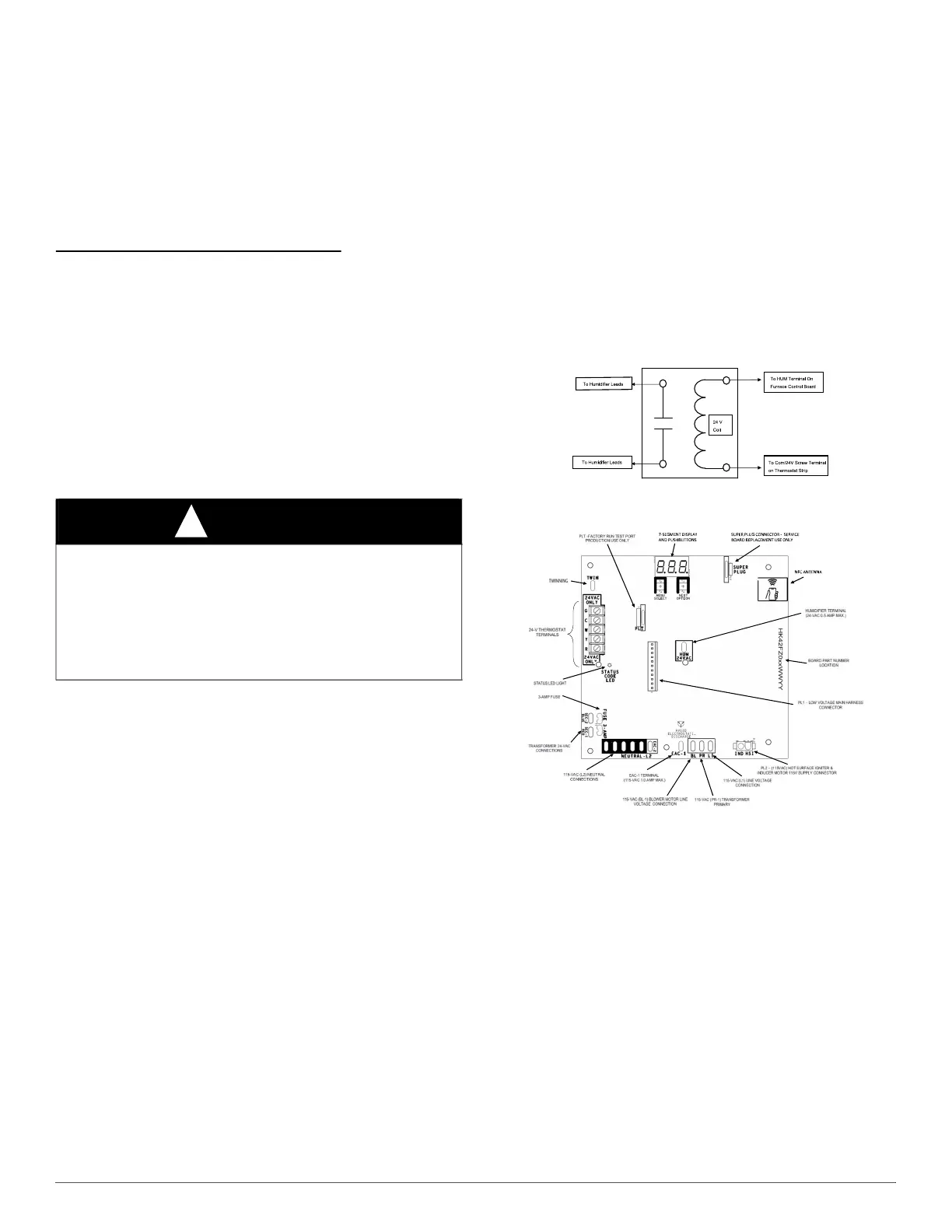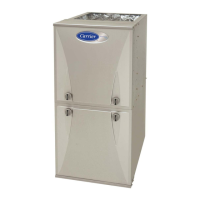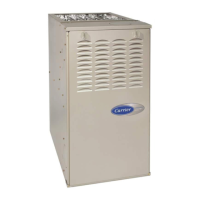PG96MSA: Installation, Start-up, Operating and Service and Maintenance Instructions
Manufacturer reserves the right to change, at any time, specifications and designs without notice and without obligations.
27
4. Pull furnace power wires through 1/2-in. (12 mm) diameter hole in
J-Box. If necessary, loosen power wires from strain—relief wire-tie
on furnace wiring harness.
5. Connect field ground wire and factory ground wire to green ground
screw on J-Box mounting bracket as shown in Fig. 34.
6. Connect power cord power and neutral leads to furnace power leads
as shown in Fig. 32.
7. Attach furnace J-Box cover to mounting bracket with screws
supplied in loose parts bag. Do not pinch wires between cover and
bracket. See Fig. 34.
BX Cable Installation in Furnace J-Box
1. Install J-Box mounting bracket to inside of furnace casing. See
Fig. 34.
2. Route BX connector through 7/8-in. (22 mm) diameter hole in
casing and J-Box bracket.
3. Secure BX cable to J-Box bracket with connectors approved for the
type of cable used.
4. Connect field ground wire and factory ground wire to green ground
screw on J-Box mounting bracket as shown in Fig. 34.
5. Connect field power and neutral leads to furnace power leads. as
shown in Fig. 32.
6. Attach furnace J-Box cover to mounting bracket with screws
supplied in loose parts bag. Do not pinch wires between cover and
bracket.
24-V Wiring
Make field 24-V connections at the 24-V terminal strip. See Fig. 37.
Connect terminal Y as shown in Fig. 32 for proper cooling operation.
Use only AWG No. 18, color-coded, copper thermostat wire.
NOTE: Use AWG No. 18 color-coded copper thermostat wire for
lengths up to 100 ft. (31 M). For wire lengths over 100 ft., use AWG No.
16 wire.
The 24-V circuit contains an automotive-type, 3-amp. fuse located on
the control. Any direct shorts during installation, service, or maintenance
could cause this fuse to blow. If fuse replacement is required, use ONLY
a 3-amp. fuse of identical size. See Fig. 37.
ACCESSORIES (See Fig. 37)
1. Electronic Air Cleaner (EAC)
Connect an accessory Electronic Air Cleaner (if used) using 1/4-in.
female quick connect terminals to the two male 1/4-in.
quick-connect terminals on the control board marked EAC-1 and
EAC-2. The terminals are rated for 115 VAC, 1.0 amps maximum
and are energized during blower motor operation.
2. Humidifier (HUM)
Connect an accessory 24 VAC, 0.5 amp. maximum humidifier (if
used) to the 1/4-in male quick-connect HUM terminal and
COM-24V screw terminal on the control board thermostat strip.
The HUM terminal is energized when the pressure switch closes
during a call for heat (See Fig. 37).
NOTE: DO NOT connect furnace control HUM terminal to HUM
(humidifier) terminal on humidity sensing thermostat, zone controller or
similar device. See humidity sensing thermostat, zone controller,
thermostat, or controller manufacturer’s instructions for proper
connection.
NOTE: For 24-V & 115-V EAC or Humidifier Accessory details, see
Accessory instructions.
Alternate Power Supplies
This furnace is designed to operate on utility generated power which has
a smooth sinusoidal waveform. If the furnace is to be operated on a
generator or other alternate power supply, the alternate power supply
must produce a smooth sinusoidal waveform for compatibility with the
furnace electronics. The alternate power supply must generate the same
voltage, phase, and frequency (Hz) as shown in Table 11 or the furnace
rating plate.
Power from an alternate power supply that is non-sinusoidal may
damage the furnace electronics or cause erratic operation.
Contact the alternate power supply manufacturer for specifications and
details.
A11157
Fig. 36 – Field-Supplied Isolation Relay for Humidifiers with
Internal Power Supply
A210192
Fig. 37 – Example of Single Stage Furnace Control
WARNING
!
FIRE, EXPLOSION, ELECTRICAL SHOCK, AND
CARBON MONOXIDE POISONING HAZARD
Failure to follow this warning could result in dangerous operation,
personal injury, death, or property damage.
Do not drill into blower shelf of furnace to route control wiring. Route
any control or accessory wiring to the blower compartment through
external holes provided on the casing.

